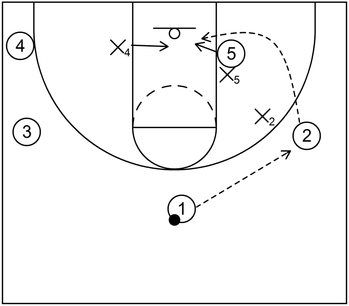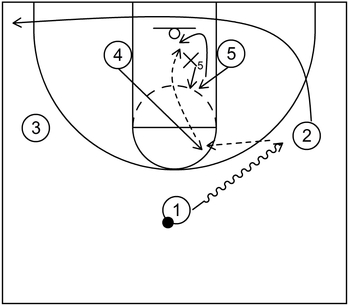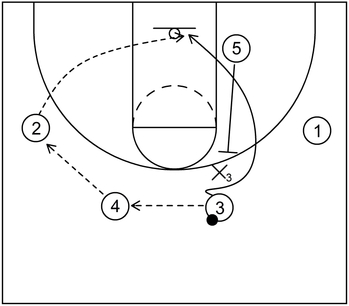What is the lob pass in basketball
The lob pass consists of offensive action that occurs when a player in possession of the basketball throws it into the air with a high arc, usually over at least one defender, to a teammate who could catch the ball and potentially score.
What are general reasons why the lob pass is potentially effective
The lob pass is potentially effective because it could be used to get the ball inside to the team’s best low post players and in certain instances, it could also be utilized alongside alley-oop action to create a quick scoring opportunity at the rim.
Get the ball to the team’s post players
The lob pass could be used to get the ball to the team’s best post players, particularly as a counter to a low post defensive front.
For example, let’s say there is a situation in which offensive player A has possession of the ball on the right side wing and offensive player B is currently positioned near the right side low post block ready to receive the ball.
However, let’s also say that there are two defenders guarding each of those offensive players with man to man defense.
Also, to keep things simple, these defenders will be referred to as defender A, who guards offensive player A, and defender B, who guards offensive player B, respectively.
Next, let’s say that defender B decides to implement a defensive front against offensive player B to ultimately hinder an easy post entry pass.
Effectively, defender B accomplishes this by placing their top foot (nearest the half court line) between both feet of offensive player B and then extends their outside arm near the chest area of offensive player B while also using a non-extended arm-bar with their inside arm near the back area of offensive player B.
From that point, if offensive player A tried to execute a standard basketball pass with offensive player B as the potential target, then there is at least a small to moderate risk that defender B would be able to deflect the ball away from its intended receiver (i.e. offensive player B), which could then result in a turnover.
Therefore, to mitigate and counter the effect of the defensive front, offensive player A could execute a lob pass as a practical response to get the ball inside to offensive player B.
Essentially, offensive player A would be able to throw the ball with a high arc (i.e. lob) over defender B so that offensive player B could catch it, particularly with their inside hand (the hand that is nearest the basket) and score in front of the rim.
The lob pass could also be used to get the ball to the team’s low post players via high low action.
As a basic example, let’s say that offensive player A has the ball at the top or near the high post area.
Following that, let’s also say that offensive player B steps into the lane in an attempt to receive the ball but defender B takes away that action with a defensive front.
At the moment of that fronting action, offensive player A could execute the lob pass by throwing the ball over defender B so that offensive player B could catch it and score near the rim with a layup or dunk.
Create potential scoring opportunities via alley-oop action
Additionally, the lob pass could potentially create scoring opportunities, particularly as a key element within alley-oop action.
Put another way, when executing basketball offense in general, an offensive player in possession of the ball could throw it with a high arc over one or more defenders towards the basket and afterwards, the ball could be caught while in mid-air by another offensive player who could then quickly score with a dunk or layup at the basket to complete the alley-oop action.
To give an example of this, let’s say that there are three offensive players denoted as offensive players A, B, and C respectively.
Let’s also say there are three defenders executing man to man defense, denoted as defenders A, B, and C, and each defender guards their respective counterpart.
From there, let’s say that offensive player A has the ball near the right side wing.
Furthermore, offensive player B is near the left side wing and offensive player C is near the left side low post area.
Moreover, offensive player A has an opportunity to get an assist by creating a scoring opportunity, specifically at the rim for offensive player B.
So, to accomplish this, offensive player C could set a back screen on defender B. Next, offensive player B could use that back screen and cut to the basket from the left side wing.
Additionally, as that occurs, let’s say that offensive player A was able to get dribble penetration into the lane area by using an explosive first step against defender A.
When that occurs, defender C has at least a couple of options to consider in terms of help defense. As for the first option, defender C could step up slightly away from the basket to prevent further dribble penetration as well as an uncontested mid-range jump shot or floater by offensive player A.
Basically, in this option, defender C is hoping that defender B would be able to fight through the screen and recover quickly in time.
As for the second option, defender C could stay back and protect the basket. If defender C chooses the first option, then offensive player A could potentially throw the lob pass over the top to offensive player B for a layup or dunk, thus completing the alley-oop action.
However, in some cases, even if defender C chooses the second option to protect the basket, offensive player A still might be able to throw the lob pass and complete the alley-oop action, especially if offensive player B has a significant size and/or athletic advantage over defender C.
What are examples of simple basketball plays that could use the lob pass
Example 1

This is a basic example of the lob pass being utilized from the right side wing area. To start, 2 receives the ball from 1 and afterwards, 5 would like to receive the ball from 2.
However, X5, the defender guarding 5, executes a low post front to hinder the easy post entry pass. As a counter to that, 2 could throw the lob pass over X5.
Also, at the same time, 5 could create separation from X5 by taking a step towards the basket while the ball is still mid-air.
Following that, 5 could catch the ball, particularly with the inside hand (that would be the left hand in this case) and score at the rim.
Also, notice that X4 was initially in good help position on the weak side of the court.
However, even if X4 slides over to protect the basket in time, 5 could still try to score which could potentially result in a foul on X4.
Additionally, if 5 is not able to take the close-range layup or dunk, then 3 or 4 could receive the ball from 5 via a kick pass and take three-point jump shots if those are open.
Example 2

This is a basic example of the lob pass used within high low action initiated from a 3 out 2 in set.
To start, 1 initiates a dribble entry towards the right side wing which also activates a deep cut to the left side corner by 2.
After that, 4 flashes up to the high post area and receives the ball from 1. X5 attempts to front the low post so that 5 cannot easily duck in and receive the ball in the lane.
Therefore, 5 decides to pivot and turn so that X5 is behind 5 on the high side. As that happens, 4 throws the lob pass over X5. Next, 5 receives the ball and scores at the rim with a layup or dunk.
Example 3

This is a simple example of alley-oop action via the lob pass within the Chin series of the Princeton offense.
To begin, 4 receives the ball from 3 and then 2 receives it from 4 to complete the ball reversal action.
Next, 3 cuts to the basket via the back screen set by 5. Also, for this example, 3 is extremely athletic and possesses a very high vertical leap.
Therefore, 2 throws the ball via a lob pass towards the basket as opposed to just throwing it towards 3. Following that, 3 could catch the ball while it is in mid-air and then dunk it to complete the alley-oop action.